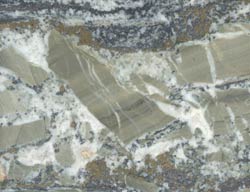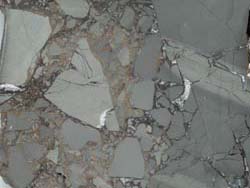J.S. Mason - Central Wales Orefield:
Breccia textures
BACK
TO CENTRAL WALES MENU
The
Central Wales ore
deposits are hosted by fault-fracture systems in which small to
moderate normal and dextral wrench-movements may be demonstrated. Most
of the fractures trend ENE with a minor suite trending NW-SE.
The fact that many breccia samples show radial growth of minerals about
clasts led to the realisation that brecciation and mineral
precipitation must have been virtually simultaneous. These are not
classic fault-breccias but "hydraulic breccias" and their mode of
formation was eloquently explained by the late W. J. Phillips in 1972.
Phillips demonstrated that hydrothermal fluids are capable of causing
fracture propagation by hydraulic means. Anyone who has used a
trolley-jack will know that half a pint of hydraulic fluid, under
compression, can lift an object weighing two or more tons off the
ground. Compressed fluid is a force to be reckoned with!
In Phillips' scenario, the pressure on a hydrothermal fluid occupying a
fracture (exerted by the fissure walls) would encourage fracture tip
propagation (in addition to the regional tensile stresses that would
create the initial conditions for fracture development). In other
words, the highly-compressed fluids at the fracture-tip would jack the
walls apart! In each episode of fracture propagation upwards. the
pressurised fluids would rush into the open space newly created. This
would cause a sudden depressurising of the fluid: this change would
cause the wallrocks, under considerable lithostatic and pore-water
pressures, to explode outwards into the newly-formed relatively
low-pressure zone. The process is not dissimilar to the rockbursts
which are an ever-present hazard in the world's deeper mines.
The exploded rock-fragments would have a seeding effect in the
depressurised hydrothermal fluid, so that minerals would nucleate on
the clasts and the cementation process would commence. In some lodes,
multiple episodes of brecciation have occurred, in which
previously-formed mineral assemblages have been rebrecciated and
cemented by later assemblages.
Some of the later assemblages depict a transition from this violent
process to more passive, open-fissure filling. The images below are
some representative samples.
Reference:
Phillips, W.J. (1972) Hydraulic fracturing and mineralisation. Journal
of the Geological Society of London, 128, 337-359.
 Early (A1) breccia: part of a cut
and polished slab from the Darren mine, Central Wales, actual size. Early (A1) breccia: part of a cut
and polished slab from the Darren mine, Central Wales, actual size.
Clasts of pale greenish-grey mudstone (belonging to the Cwmsymlog
Formation) are cemented by a matrix of tough milky quartz, with bands
of fine-grained galena, chalcopyrite and tetrahedrite. A1 breccias are
commonly matrix-supported. They occasionally contain vugs lined with
prismatic waterclear quartz crystals. |
 Late (A2) breccia: part of a cut and
polished slab from Penycefn mine, Central Wales, half actual size. Late (A2) breccia: part of a cut and
polished slab from Penycefn mine, Central Wales, half actual size.
Clasts of grey mudstone (belonging to the Borth Mudstones Formation)
are closely-spaced and cemented by a matrix of clear quartz, sphalerite
and galena. Vugs in A2 breccias are common and are lined with
noticeably squat quartz crystals. |
 Late
(A2) vein sample from Pandy mine, Central Wales, half actual size. Late
(A2) vein sample from Pandy mine, Central Wales, half actual size.
Here we have two features: firstly a thin vein containing brecciated
rock clasts (below) and secondly open fissure-fill (above) in which
mineralising fluids have precipitated quartz on open vein walls during
repeated openings. Each new fracture opening has added a new vein. The
vein-rock interface is delineated by a thin dark grey parting: some
shattering of an older vein has resulted in the partings being
disrupted as in the diagonal dark line on the R.
Open fissure-fill is a strong feature of the later (A2) assemblages. |
BACK
TO CENTRAL WALES MENU
|
 Early (A1) breccia: part of a cut
and polished slab from the Darren mine, Central Wales, actual size.
Early (A1) breccia: part of a cut
and polished slab from the Darren mine, Central Wales, actual size. Late (A2) breccia: part of a cut and
polished slab from Penycefn mine, Central Wales, half actual size.
Late (A2) breccia: part of a cut and
polished slab from Penycefn mine, Central Wales, half actual size. Late
(A2) vein sample from Pandy mine, Central Wales, half actual size.
Late
(A2) vein sample from Pandy mine, Central Wales, half actual size.